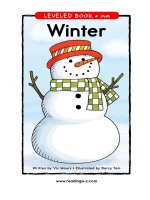raz ln30 whatlivesinthathole
Bạn đang xem bản rút gọn của tài liệu. Xem và tải ngay bản đầy đủ của tài liệu tại đây (4.42 MB, 18 trang )
What Lives
in This Hole?
A Reading A–Z Level N Leveled Book
Word Count: 577
LEVELED BOOK • N
What Lives
in This Hole?
•N
K
•
H
Written by Kira Freed
Visit www.readinga-z.com
for thousands of books and materials.
www.readinga-z.com
What Lives
in This Hole?
Written by Kira Freed
www.readinga-z.com
Elf owls
Table of Contents
My First Post! . . . . . . . . . . . . . . . . . . 4
Staying Cool . . . . . . . . . . . . . . . . . . . 6
Keeping Eggs Safe . . . . . . . . . . . . . . 7
Making a Nest . . . . . . . . . . . . . . . . . . 8
Living in the Dark . . . . . . . . . . . . . 10
Hiding and Laying Eggs . . . . . . . . 12
Staying Safe . . . . . . . . . . . . . . . . . . . 14
More to Come . . . . . . . . . . . . . . . . . 15
Glossary . . . . . . . . . . . . . . . . . . . . . . 16
What Lives in This Hole? • Level N
3
Elf owls
My First Post!
I found a big hole in the ground
two months ago on a hike. I
thought it was the opening to an
animal’s burrow. I had no idea what
kind of animal lived there, though.
I took a picture with my phone and
asked my teacher if she knew.
Table of Contents
My First Post! . . . . . . . . . . . . . . . . . . 4
Staying Cool . . . . . . . . . . . . . . . . . . . 6
Keeping Eggs Safe . . . . . . . . . . . . . . 7
Making a Nest . . . . . . . . . . . . . . . . . . 8
Living in the Dark . . . . . . . . . . . . . 10
Hiding and Laying Eggs . . . . . . . . 12
Staying Safe . . . . . . . . . . . . . . . . . . . 14
More to Come . . . . . . . . . . . . . . . . . 15
Glossary . . . . . . . . . . . . . . . . . . . . . . 16
What Lives in This Hole? • Level N
3
This is the hole that I found.
4
My teacher and I work together.
My teacher taught me how to
research to find the answer to my
question. Before long, I started
blogging! Every week, I research
the burrow of one animal. I post my
work on our class blog. Some of my
classmates have started blogging,
too. Check out my blog posts!
What Lives in This Hole? • Level N
5
Utah
Dese
Arizona
Do You Know?
orn
lif
Ca
Nevada
ia
ge
e ran
Desert tortoise burrows
can be up to 1.8 meters
(6 ft) deep. Some are only
a little bigger than the
tortoise’s shell.
Desert tortoises live in the United States and Mexico.
My teacher and I work together.
My teacher taught me how to
research to find the answer to my
question. Before long, I started
blogging! Every week, I research
the burrow of one animal. I post my
work on our class blog. Some of my
classmates have started blogging,
too. Check out my blog posts!
What Lives in This Hole? • Level N
rtois
rt to
PACIFIC
OCEAN
New
Mexico
5
Staying Cool
A desert tortoise lives in this hole!
This reptile lives in a desert. It can
only stay alive by digging a burrow
to escape the heat. The desert
tortoise spends almost all of its life
underground. It sleeps all winter to
stay warm.
6
CARIBBEAN SEA
Goliath
bird-eating
spider range
SOUTH AMERICA
Wowser!
The goliath
bird-eating
spider is the
biggest spider
in the world.
Goliath bird-eating spiders live in rainforests in South America.
Keeping Eggs Safe
A huge spider lives in this hole! The
goliath bird-eating spider lives in
a deep burrow. It may dig its own
burrow or use one that another
animal no longer uses. A female
stays in her burrow for most of her
life. She lays around fifty eggs in
a little silk bag. She takes the bag
with her if she leaves to hunt.
What Lives in This Hole? • Level N
7
CARIBBEAN SEA
GREENLAND
Goliath
bird-eating
spider range
SOUTH AMERICA
NORTH
AMERICA
Wowser!
ATLANTIC
OCEAN
Atlantic
puffin range
EUROPE
The goliath
bird-eating
spider is the
biggest spider
in the world.
Goliath bird-eating spiders live in rainforests in South America.
Keeping Eggs Safe
A huge spider lives in this hole! The
goliath bird-eating spider lives in
a deep burrow. It may dig its own
burrow or use one that another
animal no longer uses. A female
stays in her burrow for most of her
life. She lays around fifty eggs in
a little silk bag. She takes the bag
with her if she leaves to hunt.
What Lives in This Hole? • Level N
Atlantic puffins nest along the coasts of Europe and
North America.
Making a Nest
This hole belongs to Atlantic
puffins! These birds spend most of
their life on the open ocean. They
use their strong wings and webbed
feet to fly and swim. Puffins swim
much better than they fly.
7
8
A puffin feeds its chick.
Wowser!
Adult Atlantic puffins
have brightly colored
bills during the breeding
season. Their nicknames
are “sea parrots” and
“clowns of the sea.”
Atlantic puffins raise their chicks
in a burrow. They dig the burrow
on a cliff near water. They line the
burrow with seaweed, plants, or
feathers. Puffin parents take turns
caring for a single egg until it
hatches. Then one parent leaves to
get small fish to feed the chick. The
other parent keeps the chick safe.
What Lives in This Hole? • Level N
9
Wowser!
The tunnels of one naked mole rat
colony can cover as much land as
twenty football fields!
Naked
mole rat
range
INDIAN
OCEAN
A puffin feeds its chick.
Wowser!
Adult Atlantic puffins
have brightly colored
bills during the breeding
season. Their nicknames
are “sea parrots” and
“clowns of the sea.”
Naked mole rats live in dry grasslands in East Africa.
Atlantic puffins raise their chicks
in a burrow. They dig the burrow
on a cliff near water. They line the
burrow with seaweed, plants, or
feathers. Puffin parents take turns
caring for a single egg until it
hatches. Then one parent leaves to
get small fish to feed the chick. The
other parent keeps the chick safe.
What Lives in This Hole? • Level N
Living in the Dark
Naked mole rats live in this hole!
These small animals spend all of
their lives underground in the dark.
Small hairs on their face and tail
help them find their way. They dig
tunnels to find roots and other plant
parts to eat.
9
10
A naked mole rat’s long
front teeth help it dig.
Naked mole rats
dig as a team.
Naked mole rats work as a team
to build their tunnels. One animal
breaks new soil at the front of the
line. Behind it, several others use
their feet to move dirt backward.
A worker at the back kicks the dirt
up to the surface. Different parts
of the tunnels have different uses,
such as food storage or nest areas.
What Lives in This Hole? • Level N
11
A naked mole rat’s long
front teeth help it dig.
SEA OF
JAPAN
PACIFIC
OCEAN
Naked mole rats
dig as a team.
Naked mole rats work as a team
to build their tunnels. One animal
breaks new soil at the front of the
line. Behind it, several others use
their feet to move dirt backward.
A worker at the back kicks the dirt
up to the surface. Different parts
of the tunnels have different uses,
such as food storage or nest areas.
What Lives in This Hole? • Level N
A Japanese giant salamander comes out of its burrow.
Hiding and Laying Eggs
A Japanese giant salamander lives
in this underwater hole! It lives in
cool mountain rivers and streams.
During the day, it hides in a burrow
or under rocks. At night, it comes
out to hunt for food.
11
12
Wowser!
Japanese giant salamanders are
huge! They can grow as long as
1.5 meters (5 ft).
A male salamander protects the eggs.
In late summer, males and females
come together at long burrows.
Females swim into the burrows to
lay their eggs—up to five hundred!
A male watches the eggs to make
sure no fish eat them.
What Lives in This Hole? • Level N
13
Wowser!
Japanese giant salamanders are
huge! They can grow as long as
1.5 meters (5 ft).
A wombat’s burrow may be
as long as three school buses!
Wo
mb
at
ran
ge
Wowser!
SOUTH
PACIFIC
OCEAN
A mother and baby wombat look out of their burrow.
Staying Safe
A male salamander protects the eggs.
In late summer, males and females
come together at long burrows.
Females swim into the burrows to
lay their eggs—up to five hundred!
A male watches the eggs to make
sure no fish eat them.
What Lives in This Hole? • Level N
13
A wombat lives in this hole! It
digs a burrow with its huge claws.
Wombats stay in their burrows
during the day. At night, they come
out to feed on plants. They run to
their burrow if an enemy chases
them. They may also protect
themselves by fighting.
14
Do You Know?
Animals on every continent
live in burrows. Burrowing
sea urchins live in Antarctica.
This Antarctic burrowing sea urchin hides itself while it digs.
More to Come
So far, I’ve blogged about animal
holes on six continents. Are you
wondering about Antarctica? I
just learned that sea urchins live in
burrows there. Check back soon for
a post about them.
I’m going to keep doing research on
animals that live in holes. It’s so fun
to learn about the natural world!
What Lives in This Hole? • Level N
15
Glossary
Do You Know?
burrow (n.)
Animals on every continent
live in burrows. Burrowing
sea urchins live in Antarctica.
naked mole
rats (n.)
puffins (n.)
This Antarctic burrowing sea urchin hides itself while it digs.
More to Come
So far, I’ve blogged about animal
holes on six continents. Are you
wondering about Antarctica? I
just learned that sea urchins live in
burrows there. Check back soon for
a post about them.
I’m going to keep doing research on
animals that live in holes. It’s so fun
to learn about the natural world!
What Lives in This Hole? • Level N
15
research (v.)
a hole dug in the
ground by an animal
for use as a home (p. 4)
burrowing, almost
hairless rodents that
are nearly blind and
live in Africa (p. 10)
any of three kinds of
diving seabirds known
for their brightly
colored beaks (p. 8)
to study or investigate,
especially to discover
new information or to
find facts (p. 5)
salamander (n.) a kind of amphibian
that has smooth, wet
skin, a long tail, and
short legs (p. 12)
wombat (n.)
a burrowing mammal
with a pouch and short
legs that looks similar
to a small bear (p. 14)
16
What Lives
in This Hole?
A Reading A–Z Level N Leveled Book
Word Count: 577
LEVELED BOOK • N
What Lives
in This Hole?
•N
K
•
H
Written by Kira Freed
Visit www.readinga-z.com
for thousands of books and materials.
www.readinga-z.com
What Lives
in This Hole?
Written by Kira Freed
www.readinga-z.com
Photo Credits:
Front cover: © Evan Sharboneau/123RF; back cover: © Chris Newbert/Minden
Pictures; title page: © Claus Meyer/Minden Pictures; page 3: © Rick & Nora
Bowers/Alamy; page 4: © NHPA/SuperStock; page 5: © Design Pics/SuperStock;
page 6: © Ralph Clevenger/Corbis; page 7: © James H. Robinson/Photo
Researchers, Inc.; page 8: © age fotostock/SuperStock; page 9 (top): © Mark
Colombus/Alamy; page 9 (bottom): © Matt Caldwell/123RF; page 10: © Neil
Bromhall/Photo Researchers, Inc.; page 11 (left): © Exactostock/SuperStock; page 11
(right): © Pat Morris/ardea.com; pages 12, 13: © Cyril Ruoso/Minden Pictures;
page 14: © Dave Watts/Alamy; page 15: © Norbert Wu/Science Faction/SuperStock
Back Cover: Coral hermit crab
Title Page: Yellow armadillo
What Lives in This Hole?
Level N Leveled Book
© Learning A–Z
Written by Kira Freed
All rights reserved.
www.readinga-z.com
Correlation
LEVEL N
Fountas & Pinnell
Reading Recovery
DRA
M
20
28









